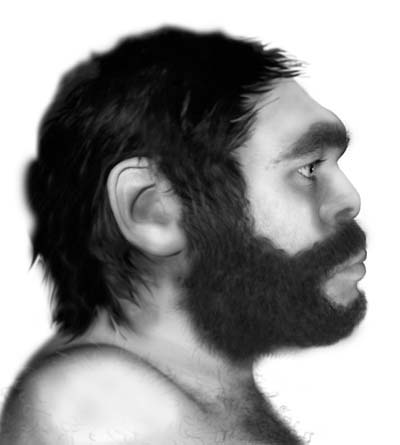Researchers at the Max Planck Institute for Evolutionary Biology in Leipzig, Germany, plan to reconstruct the genome of Neanderthals, the archaic human species that occupied Europe from 300,000 years ago until 30,000 years ago until being displaced by modern humans. Scientists Plan to Rebuild
Neanderthal GenomeThe genome will initially be reconstructed using DNA extracted from Neanderthal bones that are 45,000 years old, which were found in Croatia, though bones from other sites may be analyzed later.
The project is a collaboration between Dr. Svante Paabo of the Max Planck Institute for Evolutionary Anthropology in Leipzig, Germany, and 454 Life Sciences, a Connecticut company that has developed a new method of sequencing, or decoding, DNA.
The sequencing of Neanderthal DNA, long a forlorn hope, suddenly seems possible because of a combination of analytic work on ancient DNA by Dr. Paabo and a new kind of DNA sequencing machine developed by 454 Life Sciences.
Because the genome must be kept in constant repair and starts to break up immediately after the death of the cell, the DNA in Neanderthal bones exists in tiny fragments 100 or so units in length. As it happens, this is just the length that works best with the 454 machine, which is also able to decode vast amounts of DNA at low cost.
Recovery of the Neanderthal genome, in whole or in part, would be invaluable for reconstructing many events in human prehistory and evolution. It would help address such questions as whether Neanderthals and humans interbred, whether the archaic humans had an articulate form of language, how the Neanderthal brain was constructed, if they had light or dark skins, and the total size of the Neanderthal population.
The project is still at an early stage but much groundwork has already been laid. Most Neanderthal bones contain no Neanderthal DNA at all, but almost all are heavily contaminated with the human DNA of the many people who handled the bones. Dr. Paabo has developed stringent methods to address this contamination problem.
Even with the DNA that is known to be ancient, some 95 percent of that in Neanderthal bones belongs to ancient bacteria, said Michael Egholm, a vice president of 454 Life Sciences. But these bacterial sequences can be recognized and discarded, Dr. Egholm said.
Because Neanderthal DNA is so scarce, Dr. Paabo and the 454 researchers developed their methods on ancient DNA from cave bears and mammoth.
Turning to Neanderthal bones, they have already recovered considerable amounts of DNA sequence, which are derived from every chromosome in the Neanderthal cell, as judged by matching the Neanderthal DNA to the human genome sequence that was first fully decoded in 2003.
The first goal of the project will be to sequence three billion units of Neanderthal DNA, corresponding to the full length of the Neanderthal genome. This will require decoding 20 times as much DNA, because so much of the DNA in the Neanderthal bones belongs to bacteria.
Genomes must usually be decoded several times over to get a complete and accurate sequence, but the first three billion bases of Neanderthal should “hit all the essential differences,” Dr. Egholm said.
The researchers’ hope is to recover the entire sequence of the Neanderthal genome, but that will depend on which they can recover enough DNA. From sampling so far, no particular gaps in the sequence are apparent. “We are hitting all the chromosomes and getting good coverage,” Dr. Egholm said. If no single specimen yields a full sequence, the genome might be recovered by combining DNA from several individuals.
One of the most important results that researchers are hoping for is to discover, from a three-way comparison between chimp, human and Neanderthal DNA, which genes have made humans human. The chimp and human genomes differ at just 1 percent of the sites on their DNA. At 1 percent, Neanderthals resemble humans at 96 percent of the sites, to judge from the preliminary work, and chimps at 4 percent. Analysis of the DNA at the sites at which humans differ from the two other species will help understand the evolution of specifically human traits “and perhaps even aspects of cognitive function,” Dr. Paabo said.
The degree of resemblance between humans and Neanderthals is fiercely debated by archaeologists and even issues such as whether Neanderthals had language have not been resolved.
Dr. Paabo believes that genetic analysis is the best hope of doing so. He has paid particular attention to a gene known as FOXP2, which from its mutated forms in people seems to be involved in several advanced aspects of language. The human version of the gene differs at two sites from the chimp version. Knowing whether the sequence of the Neanderthal gene is closer to chimps or humans would help decide whether they had advanced speech like people or some lesser form of communication, perhaps without syntax.
“I suspect they had language in some form but perhaps not quite as we do it,” Dr. Paabo said. Asked if he had already had hit the FOXP2 gene in the Neanderthal sequencing done so far, he said “No, that would be just too lucky.”
If the Neanderthal genome were fully recovered, it might in principle be possible to bring the species back from extinction by inserting the Neanderthal genome into a human egg and having volunteers bear Neanderthal infants. There would, however, be great technical and ethical barriers to any such venture.
Primates.com
The Neanderthal's Last Stand?
Genocide: did early humans exterminate the Neanderthals?
info@neanderthal-man.com
